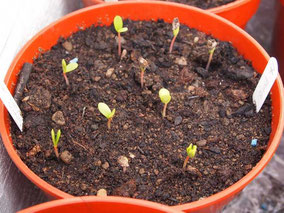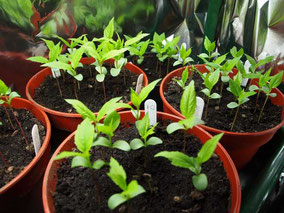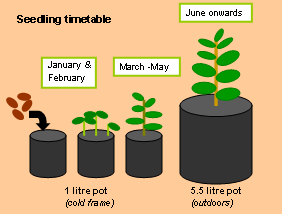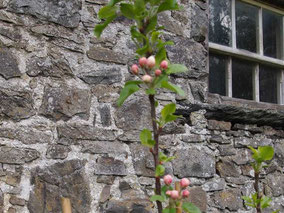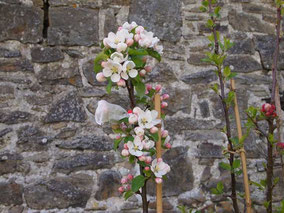Apple Breeding Programme
Seedling production
Updated June 2020
Harvesting and seed treatment
Apples produced from successful crosses are harvested when ripe (August - November), usually when the seeds (pips) have begun to turn brown. Earlier harvest may be necessary if fruit is damaged by pests or disease. Our success rates with crosses are listed on the pollination & fruit set page of this site. Unblemished apples are stored on shelves in a shed for a few weeks if required, prior to cutting open and removing the seeds. Seeds are removed from damaged or rotting apples immediately after harvest. Any seeds that have failed to develop properly are discarded at this point.
We have tested different seed-treatments aimed at minimising fungal infection prior to sowing. This is our favoured method:-
- Seeds from a given cross are rinsed thoroughly under tap water, then placed in a plastic container and soaked for 5 minutes in Calcium Hypochlorite suspension (10 g solid in 140 ml water) to counter fungal infection.
- After rinsing again with tap water, the seeds are soaked in tap water for three days, replacing the water daily. This treatment supposedly removes germination-inhibiting compounds. The soaking solution sometimes has a brown colouration indicating leaching of compounds from the seed coat.
- The seeds are blotted dry then placed in labelled, sealable polythene bags (7 cm x 4 cm) containing a few grams of dried vermiculite + 0.5 ml tap water. This provides a moist rather than wet environment. The bags are sealed and stratified (low temperature treatment) in a fridge (4°C) for over 60 days. A small proportion of the seeds may germinate during stratification; this varies with different crosses.
Planting seeds

Once stratified the seeds are sown into plastic pots during early January. Up to 12 seeds from the same cross are sown into a 16 cm diameter pot. Smaller pots are used with < 5 seeds. Pots are filled with an equal parts mixture of multi-purpose and loam-based seed composts. Seeds are pressed into the surface, edge up, with the end from which the radicle emerges down-most. They are covered with 1 cm of compost before firming the surface by hand.
Labelled pots are lightly watered and placed in cold frames. Once the seedlings emerge (3-7 weeks later), the pots are watered weekly, depending on the weather. Our germination rates are listed on the seed storage & germination page of this site. Seed-coats trapping cotyledons and preventing their unfolding for more than a few days are removed with tweezers. Emergence rates using this approach were 81% in 2017, 80% in 2018, 87% in 2019, but only 54% in 2020.
Seedling care during first year

Seedlings are transplanted at the two or three true leaf stage into individual cylindrical 1 litre plastic, or polythene sleeve, pots filled with an equal parts
mixture of multi-purpose and John Innes No. 2 compost. Each pot is double labelled with year of cross/cross number/seedling number (e.g. 2019-8-1) and placed in a cold frame. The cold
frames are opened during sunny weather and closed at night. Towards the end of May or early June, seedlings are transplanted into individual 5 litre pots,
filled with an equal parts mixture of multi-purpose compost and good topsoil, incorporating controlled release (9 month) fertiliser granules. Seedlings are supported with 24” plant sticks and
later with 4 ft bamboo canes. The pots are transferred into their permanent positions in nursery beds, half sunk into ground and mulched with turf and rough compost. The distance between
adjacent seedlings in these rows is about 9 inches, equivalent to the diameter of the pot.
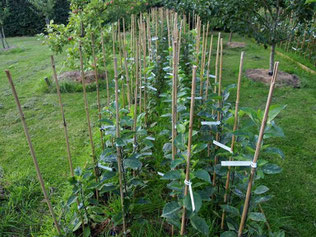
Seedlings are grown on their own roots in these 5 litre pots throughout the juvenile phase of development. We encourage them to pass through this phase as quickly as possible and then to flower. This is best achieved by maximising growth of the main leader, in order to increase the production of leaf nodes. Consequently, we don’t prune the seedlings during their first winter, leaving the main leader intact, except when pests or diseases cause die-back of the tip.
Seedling care during subsequent years

Our seedling management throughout the juvenile phase aims to maximise the extension growth of the single main leader, together with the number of internodes this shoot produces. We apply a top-dressing of controlled release (9 month) fertiliser in February. This is sufficient for the whole year’s growth. We also top up soil levels on a regular basis. The pots are watered during dry periods in the summer, although the requirement for watering is reduced by sinking them into the ground.
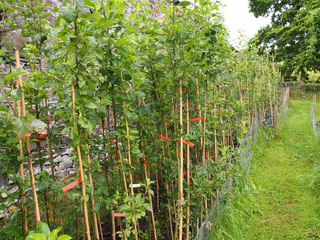
In view of the close spacing of seedlings, we aim to develop a ‘columnar’ growth form. Consequently, from year one onwards, we summer-prune any lateral shoots formed back to 3 leaves above the basal cluster. However, from year two onwards we leave a few laterals intact in case the seedling is tip-bearing rather than spur-bearing with respect to flowering. Winter pruning is confined to tipping back longer laterals to between 3-5 leaf buds, leaving the leading shoot unpruned, until the seedling flowers. Towards the end of the second year the supporting 4 ft bamboo canes are replaced by 7 or 8 ft canes inserted into the soil immediately adjacent to the 5 liter pots.Tied with string, these canes support the seedlings throughout the remaining years of juvenile growth.
Flowering of seedlings
It is too early in our programme to say much about flowering. We began crossing in earnest during 2013. Given the seedling growth rates we are achieving outdoors, we expect flowering of the most precocious seedlings to commence during their fourth year of growth.
A few seedlings from our earliest crosses, made in 2010, flowered during 2014, their fourth year of growth. The example opposite shows the increase in abundance of flowers on one of these seedlings between years 4 and 5 of growth.
During 2015, 2016 and 2017, increasing numbers of seedlings from crosses made in 2010 and 2011 flowered. All these seedlings produced at least 122 leaf nodes along the single leading shoot by the end of the year preceding flowering. On the other hand, only 40% of seedlings attaining 122 nodes or more actually flowered during the following year.
Selection and scoring of seedlings
We are not currently (2019) selecting seedlings on the basis of performance during the juvenile phase. This is because we are collecting data on seedling growth under our growing conditions. Seedlings are scored at the end of the growing season for height, number of nodes on the single leader, and pest and disease damage. Provisional results can be found on the seedling height & nodes page of this site. Adult traits will be scored in future years, allowing us to develop site-specific, quantitative relationships between seedling and adult traits.
A handful of seedlings die during their first year of growth, out of several hundred produced each year.
